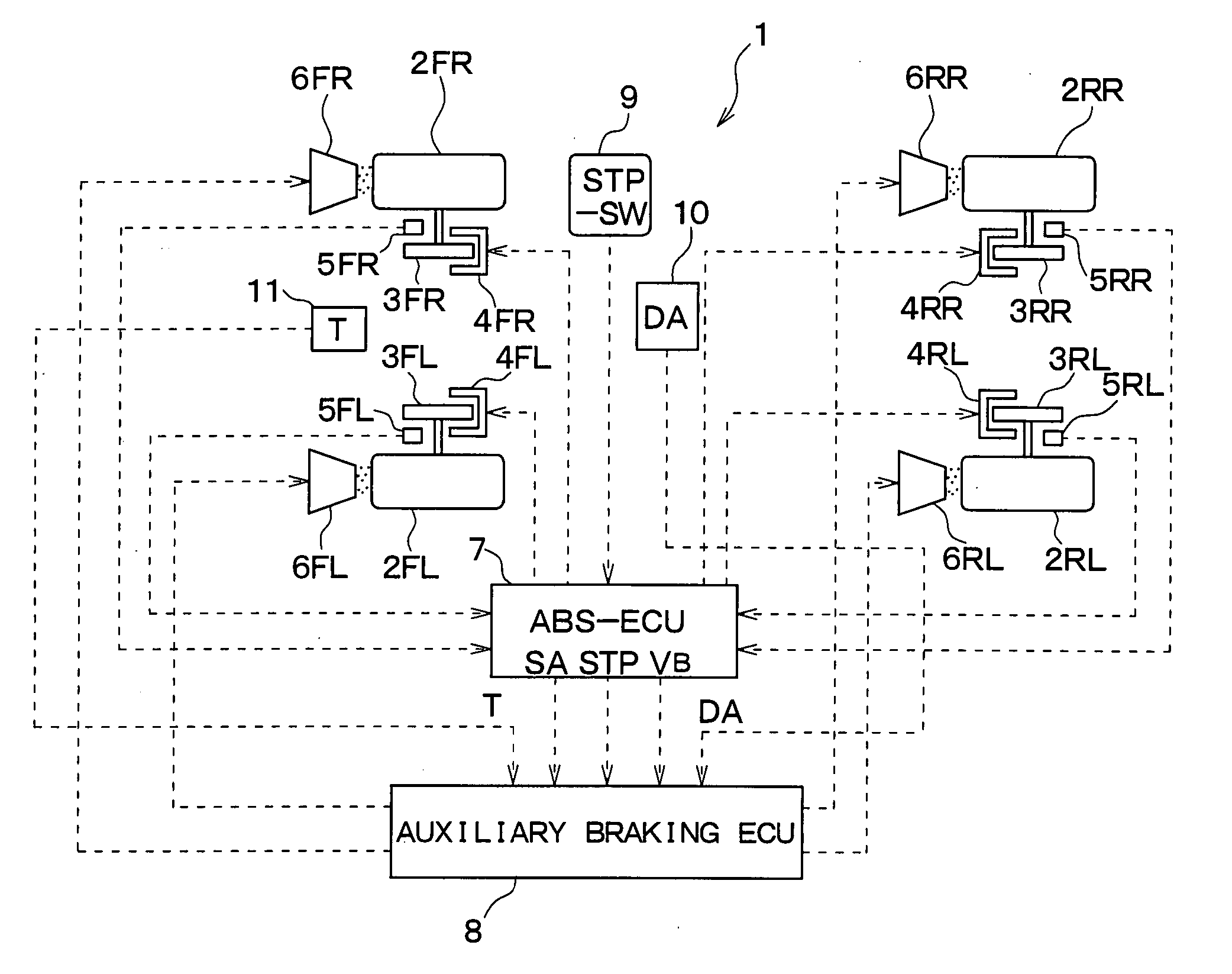Vehicle brake system for increasing friction coefficient
a technology of friction coefficient and brake system, which is applied in the direction of brake system, brake component arrangement, brake element arrangement, etc., can solve the problems of increasing the possibility of wheel slippage and other problems, and achieve the effect of reducing the friction coefficient of the road surface, increasing the friction coefficient, and lowering the electric resistance valu
- Summary
- Abstract
- Description
- Claims
- Application Information
AI Technical Summary
Benefits of technology
Problems solved by technology
Method used
Image
Examples
first embodiment
[0031]FIG. 1 is a schematic drawing showing an overall structure of a vehicle brake system according to a first embodiment of the present invention. The first embodiment is provided with an ABS control device (hereinafter referred to as ABS-ECU) 7 constructed from a microcomputer to operate an electromechanical brake device (hereinafter referred to as EMB) of each wheel. Note that a vehicle 1 is equipped with four wheels, each respectively provided with identical EMBs that are denoted as FR, FL, RR, and RL in FIG. 1. The front right wheel (FR) is described below, and descriptions of other wheels are omitted. In addition, a road surface friction coefficient that is the friction coefficient between a tire and road surface is hereinafter referred to as a road surface μ.
[0032] A disc rotor 3FR is mounted to a tire 2FR as a wheel, and integrally rotates with the tire 2FR. A caliper 4FR is provided such that the disc rotor 3FR is sandwiched therebetween. An electric motor (not shown) ser...
second embodiment
[0051] A second embodiment of the present will be described next. FIG. 3 is a schematic drawing showing an overall structure of a vehicle brake system according to the second embodiment of the present invention; FIG. 4 is a drawing of the vehicle 1 according to the second embodiment viewed from the front; and FIG. 5 is a flowchart showing processing of a program that executes an auxiliary brake control in the second embodiment. It should be noted that structures and processing similar to the above first embodiment are identically numbered and descriptions thereof are omitted.
[0052] The vehicle brake system according to the second embodiment differs from the first embodiment in that an electric resistance measuring unit 12 is provided in place of the acceleration sensor 10 and the outside temperature sensor 11.
[0053] The electric resistance measuring unit 12, as shown in FIG. 4, is provided on an under surface of the vehicle 1 between front right and left wheels 2FR, 2FL, and a det...
third embodiment
[0058] A third embodiment of the present invention will be described next. FIG. 6 is a schematic drawing showing an overall structure of a vehicle brake system according to the third embodiment of the present invention, and FIG. 7 is a flowchart showing processing of a program that executes an auxiliary brake control in the third embodiment. It should be noted that structures and processing similar to the above first and second embodiments are identically numbered and descriptions thereof are omitted.
[0059] The vehicle brake system according to the third embodiment differs from the first embodiment in that a wiper switch (wiper SW) 13 is provided in place of the acceleration sensor 10 and the outside temperature sensor 11. When a wiper device to wipe water droplets from a front windshield is automatically or manually turned ON to operate, the wiper SW 13 supplies a wiper operation signal WP to the auxiliary brake ECU 8 in response to the ON state. That is, it can be estimated from ...
PUM
 Login to View More
Login to View More Abstract
Description
Claims
Application Information
 Login to View More
Login to View More - R&D
- Intellectual Property
- Life Sciences
- Materials
- Tech Scout
- Unparalleled Data Quality
- Higher Quality Content
- 60% Fewer Hallucinations
Browse by: Latest US Patents, China's latest patents, Technical Efficacy Thesaurus, Application Domain, Technology Topic, Popular Technical Reports.
© 2025 PatSnap. All rights reserved.Legal|Privacy policy|Modern Slavery Act Transparency Statement|Sitemap|About US| Contact US: help@patsnap.com



